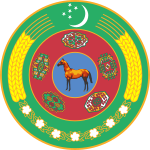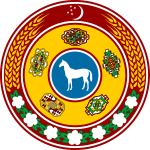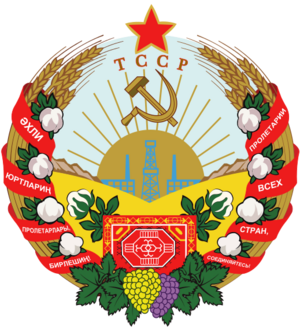Emblem of Turkmenistan facts for kids
Quick facts for kids Emblem of Turkmenistan |
|
|---|---|
 |
|
| Versions | |

2000–2003
|
|

1992–2000
|
|
| Armiger | Turkmenistan |
| Crest | A crescent and five mullets argent |
| Blazon | A disc azure, a depiction of an Akhal-Teke horse on a circular disc gules with a five carpet guls surrounds the sheaves of wheat and seven flowers in bottom. |
| Other elements | An emblem is placed in an eight-point starburst (known as the Rub El Hizb (۞) vert |
The State Emblem of Turkmenistan is a special symbol for the country. It was created after Turkmenistan became independent from the Soviet Union in 1991.
Like other countries that used to be part of the Soviet Union, Turkmenistan's emblem still has some parts from the old Soviet design. These include cotton, wheat, and a rug pattern.
The main part of the emblem is a green eight-point star. This star is called the Rub el Hizb (۞) and is a symbol often seen in Islam, which most Turkmen people follow. Inside this star, there is a red circle. This circle shows bundles of wheat and five special carpet patterns called guls. In the very middle, there is a smaller blue circle with a picture of a famous Akhal-Teke horse named Yanardag. This horse was very important to the Turkmen people.
From 1992 to 2003, a round version of the emblem was used. Then, the president suggested changing it to the current eight-point star shape. He said that the ancient Turkmen octagon (eight-sided shape) meant abundance, peace, and quiet.
Contents
What do the symbols mean?
The Emblem of Turkmenistan, or Türkmenistanyň gerbi, shows the rich history and culture of the Turkmen people. It connects to their ancestors, like Oghuz Khagan and the Seljuq dynasty. These ancient leaders built powerful empires that greatly influenced the Turkmen people.
Carpet Patterns and Tribes
The five traditional carpet patterns on the red circle stand for the five main tribes of Turkmenistan. These patterns show the country's old traditions and religious values. The tribes are:
- Teke
- Yomut
- Ärsary
- Chowdur
- Saryk
Some smaller tribes are not shown on the emblem.
Colors and Other Symbols
The green and red colors in the emblem are very important to the Turkmen people. They have been respected for a long time. The bundles of wheat around the center remind us of the custom of welcoming guests with salt and bread. They also suggest that Turkmenistan is where white wheat first grew.
Above the wheat and the red circle, there is a white crescent moon and five white five-pointed stars. The crescent moon is a common symbol for Turkic peoples and means the country hopes for a bright future. The five stars stand for the five main areas, or welayatlar, of Turkmenistan:
- Ahal
- Balkan
- Dashoguz
- Lebap
- Mary
Many of these symbols, like the crescent moon and stars, can also be seen on the national flag.
Before Turkmenistan became independent, it had an emblem similar to other Soviet countries. That emblem had only one carpet pattern, which was not like any of the tribal designs.
Where is the emblem used?
The Turkmen emblem is used in many official places. You can see it on desks during important meetings and gatherings.
See also
 In Spanish: Emblema nacional de Turkmenistán para niños
In Spanish: Emblema nacional de Turkmenistán para niños



